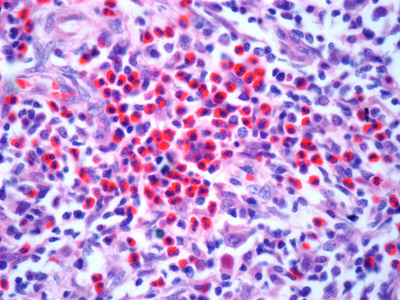The research tool: pcPPT-mPGK-attR-sLPmCherry-WPRE
One of the major challenges for tumour research is identifying how tumour cells exploit their surrounding cells, the so-called tumour microenvironment (TME), to help form and expand the tumour itself.
Existing methods can be used to investigate this challenge, but all have disadvantages; for example, immunohistochemistry allows you to view the location of the TME cells but only in fixed samples, whilst flow cytometry allows the detection of different cell types within a tissue, but doesn’t show spatial information to specifically identify TME cells (Frontiers in Oncology 2018, 00390). A major advance in this field, would be to be able to specifically isolate the cells that have been corrupted, to understand the exact nature of how these cells were hijacked to support tumour progression.
The contributor
The Francis Crick Institute
Facing the challenge
Ilaria Malanchi and Luigi Ombrato, researchers at The Francis Crick Institute, were working on this challenge. They were growing frustrated with the lack of available tools to isolate cells surrounding the tumour mass at the point of tumour corruption. They decided a new system was needed to tackle this challenge of identifying cells within the TME, isolating them and then studying exactly what they are. Although both were aware of the challenges involved in this task and were dubious that they would even succeed, the need for the tool outweighed the challenges. Ilaria and Luigi took inspiration from different sources of literature and developed a system to engineer tumour cells, giving them the unique ability of labelling their surrounding cells. It took a lot of resilience, dedication and alterations, but after almost three years, they had a vector they thought could work; pcPPT-mPGK-attR-sLPmCherry-WPRE.
Introducing the pcPPT-mPGK-attR-sLPmCherry-WPRE vector
The pcPPT-mPGK-attR-sLPmCherry-WPRE vector is a breakthrough in tumour research. It allows for spatial identification of the local metastatic cellular environment within the whole tissue. Lentiviral transduction is used to introduce the vector to tumour cells which can then themselves be introduced to the study host. In vivo, these cells release the cell-penetrating fluorescent red protein mCherry, which is taken up by neighbouring cells within the TME. Once the tumour environment has developed, cells can be harvested and analysed by FACS. The results enable identification of cell types directly engaged by the tumour and comparison with remaining unlabelled cells from the same tissue. Malanchi and Ombrato have shared protocols on how to engineer this vector for different cell types, giving researchers a powerful tool to apply across a variety of research areas including cancer and immunology, among others. Application of this new tool has enabled the Malanchi lab to identify the unprecedented presence of cancer associated parenchymal cells (CAPs) within the lung metastatic environment of breast cancer (Nature, 2019; 572(7771): 603-608).
Accelerating cancer research through research tools
Before joining the Francis Crick Institute, Luigi had never considered depositing his research tools. However, through the Francis Crick Institute’s partnership with CancerTools.org, Ilaria and Luigi were able to quickly and efficiently deposit their vector.
”Making our research tools available is what we are all aiming for in a way – Looking at the benefits that our findings and science can have. I think it’s really important that people who do research have the possibility to translate it, but they need support. Scientists don’t necessarily have the skills to translate their research by themselves - they need support to be able to do the next step.
Luigi Ombrato
Having been through the process of depositing their research tools, Luigi firmly believes in the importance of making their research tools available to other scientists.
”The deposit process was a very smooth process. Our technology transfer team at the Institute were always available and were very proactive in coming to us to propose things. I didn’t know about CancerTools.org beforehand and wouldn’t have known to contact them without the technology transfer team
Luigi Ombrato

Conclusion: impact of the vector
Following the publication and translation of the pcPPT-mPGK-attR-sLPmCherry-WPRE vector in Nature, CancerTools.org has received enquiries from researchers around the world for access to the research tool. In addition, 10 global working groups have been already using the vector in a variety of research areas including breast cancer metastasis and leukaemia, with results from some of these groups expected to be published shortly.





